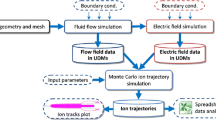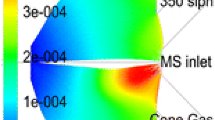Abstract
Three-dimensionally (3D) resolved ion trajectory calculations within the complex viscous flow field of an atmospheric pressure ion source are presented. The model calculations are validated with spatially resolved measurements of the relative sensitivity distribution within the source enclosure, referred to as the distribution of ion acceptance (DIA) of the mass analyzer. In previous work, we have shown that the DIA shapes as well as the maximum signal strengths strongly depend on ion source operational parameters such as gas flows and temperatures, as well as electrical field gradients established by various source electrode potentials (e.g., capillary inlet port potential and spray shield potential). In all cases studied, distinct, reproducible, and, to some extent, surprising DIA patterns were observed. We have thus attempted to model selected experimental operational source modes (called operational points) using a validated computational flow dynamics derived 3D-velocity field as an input parameter set for SIMION/SDS, along with a suite of custom software for data analysis and parameter set processing. Despite the complexity of the system, the modeling results reproduce the experimentally derived DIA unexpectedly well. It is concluded that SIMION/SDS in combination with accurate computational fluid dynamics (CFD) input data and adequate analysis software is capable of successfully modeling operational points of an atmospheric pressure ion (API) source. This approach should be very useful in the computer-aided design of future API sources.

ᅟ






Similar content being viewed by others
Notes
Freely accessible at http://dia.ipams.uni-wuppertal.de
References
Covey, T.R., Thomson, B.A., Schneider, B.B.: Atmospheric pressure ion sources. Mass Spectrom. Rev. 28, 870–897 (2009)
Bruins, A.: Mass spectrometry with ion sources operating at atmospheric pressure. Mass Spectrom. Rev. 10, 53–77 (1991)
de Hoffmann, E., Stroobant, V.: Mass spectrometry: Principles and applications, 3rd edn. John Wiley and Sons, Chichester, UK (2007)
Whitehouse, C.M., Dreyer, R.N., Yamashita, M., Fenn, J.B.: Electrospray interface for liquid chromatographs and mass spectrometers. Anal. Chem. 57, 675–679 (1985)
Bruins, A.P., Covey, T.R., Henion, J.D.: Ion spray interface for combined liquid chromatography/atmospheric pressure ionization mass spectrometry. Anal. Chem. 59, 2642–2646 (1987)
Bruins, A.P., Cook, K.D.: Electrospray ionization: Principles and instrumentation. In: Gross, M.L., Caprioli, R.N. (eds.) The encyclopedia of mass spectrometry, Vol. 6, Ionization methods, 1st edn. Elsevier, Oxford (2007)
Carroll, D.I., Dzidic, I., Stillwell, R.N., Haegele, K.D., Horning, E.C.: Atmospheric pressure ionization mass spectrometry. Corona discharge ion source for use in a liquid chromatograph-mass spectrometer-computer analytical system. Anal. Chem. 47, 2369–2373 (1975)
Moini, M.: Atmospheric pressure chemical ionization: Principles, instrumentation, and applications. In: Gross, M.L., Caprioli, R.N. (eds.) The encyclopedia of mass spectrometry, Vol. 6, ionization methods, 1st edn. Elsevier, Oxford (2007)
Harper, J.D., Charipar, N.A., Mulligan, C.C., Zhang, X., Cooks, R.G., Ouyang, Z.: Low-temperature plasma probe for ambient desorption ionization. Anal. Chem. 80, 9097–9104 (2008)
Andrade, F.J., Shelley, J.T., Wetzel, W.C., Webb, M.R., Gamez, G., Ray, S.J., Hieftje, G.M.: Atmospheric pressure chemical ionization source. 1. Ionization of compounds in the gas phase. Anal. Chem. 80, 2646–2653 (2008)
Robb, D.B., Covey, T.R., Bruins, A.P.: Atmospheric pressure photoionization: An ionization method for liquid chromatography-mass spectrometry. Anal. Chem. 72, 3653–3659 (2000)
Constapel, M., Schellenträger, M., Schmitz, O.J., Gäb, S., Brockmann, K.J., Giese, R., Benter, T.: Atmospheric-pressure laser ionization: A novel ionization method for liquid chromatography/mass spectrometry. Rapid Commun. Mass Spectrom. 19, 326–336 (2005)
Atkins, P., De Paula, J.: Atkins’ Physical chemistry, 8th edn. Oxford University Press, Oxford (2006)
Benter, T.: Atmospheric pressure laser ionization. In: Gross, M.L., Caprioli, R.N. (eds.) The encyclopedia of mass spectrometry, vol. 6, ionization methods, 1st edn. Elsevier, Oxford (2007)
Boesl, U.: Laser mass spectrometry for environmental and industrial chemical trace analysis. J. Mass Spectrom. 35, 289–304 (2000)
Kersten, H., Funcke, V., Lorenz, M., Brockmann, K.J., Benter, T., O’Brien, R.: Evidence of neutral radical induced analyte ion transformations in APPI and near-VUV APLI. J. Am. Soc. Mass Spectrom. 20, 1868–1880 (2009)
Wissdorf, W., Pohler, L., Klee, S., Müller, D., Benter, T.: Simulation of ion motion at atmospheric pressure: Particle tracing versus electrokinetic flow. J. Am. Soc. Mass Spectrom. 23, 397–406 (2012)
Poehler, T., Kunte, R., Hoenen, H., Jeschke, P., Wissdorf, W., Brockmann, K.J., Benter, T.: Numerical simulation and experimental validation of the three-dimensional flow field and relative analyte concentration distribution in an atmospheric pressure ion source. J. Am. Soc. Mass Spectrom. 22, 2061–2069 (2011)
Wissdorf, W., Seifert, L., Derpmann, V., Klee, S., Vautz, W., Benter, T.: Monte Carlo simulation of ion trajectories of reacting chemical systems: mobility of small water clusters in ion mobility spectrometry (IMS). J. Am. Soc. Mass Spectrom. 24, 632–641 (2013)
Lorenz, M., Schiewek, R., Brockmann, K.J., Schmitz, O.J., Gäb, S., Benter, T.: The distribution of ion acceptance in atmospheric pressure ion sources: Spatially resolved APLI measurements. J. Am. Soc. Mass Spectrom. 19, 400–410 (2008)
Kersten, H., Lorenz, M., Brockmann, K.J., Benter, T.: Evaluation of the performance of small diode pumped UV solid state (DPSS) Nd:YAG lasers as new radiation sources for atmospheric pressure laser ionization mass spectrometry (APLI-MS). J. Am. Soc. Mass Spectrom. 22, 1063–1069 (2011)
Wissdorf, W., Lorenz, M., Brockmann, K.J., Schmitz, O.J., Gäb, S., Benter, T.: Determination of the distribution of ion acceptance (DIA) of atmospheric pressure ionization sources. Proceedings of the 55th ASMS Conference on Mass Spectrometry and Allied Topics, Indianapolis (2007)
Brockmann, K.J., Lorenz, M., Schiewek, R., Constapel, M., Schellenträger, M., Mangas Suárez, A., Schmitz, O.J., Gäb, S., Benter, T.: Determination of the dynamic ion acceptance volume in atmospheric pressure ionization sources using APLI. Proceedings of the 54th ASMS Conference on Mass Spectrometry and Allied Topics, Seattle (2006)
The MathWorks, Matlab R2010b, Natick, MA, USA, http://www.mathworks.com. Accessed May 2013
Python Software Foundation, Python 2.7, http://www.python.org. Accessed May 2013
SciPy Community, SciPy 0.10.1, http://www.scipy.org. Accessed May 2013
Oracle Corporation, Java 6, Redwood Shores, CA, USA
Westerweel, J.: Fundamentals of digital particle image velocimetry. Measurement Sci. Technol. 8, 1379–1392 (1997)
Ansys Inc., CFX v.12.1, Canonsburg, PA, USA, http://www.ansys.com. Accessed May 2013
Raffel, M., Willert, C.E., Wereley, S.T., Kompenhans, J.: Particle Image Velocimetry. A Practical Guide, 2nd edn. Springer, New York (2007)
Crank, J.: The mathematics of diffusion. Oxford University Press, Oxford (1975)
Versteeg, H., Malalasekra, W.: An introduction to computational fluid dynamics: The finite volume method approach. Prentice Hall, Essex (1996)
Scientific Instrument Services Inc., SIMION ver. 8.0.4, Ringoes, NJ, USA, http://www.simion.com. Accessed May 2013
Appelhans, A.D., Dahl, D.A.: SIMION ion optics simulations at atmospheric pressure. Int. J. Mass Spectrom. 244, 1–14 (2005)
Computational Engineering International Inc., EnSight ver. 10 User Manual, 2011.
Kitware Inc., Visualization Toolkit (VTK) 5.6.0, Clifton Park, NY, USA, http://www.vtk.org. Accessed May 2013
Oliphant T. & NumPy Community, NumPy 1.5 http://www.numpy.org. Accessed May 2013
Hunter J. & Matplotlib Community, Matplotlib 1.1, http://matplotlib.org/. Accessed May 2013
Wissdorf, W., Lorenz, M., Kersten, H., Klee, S., Brockmann, K.J., Benter, T.: Atmospheric pressure laser ionization (APLI): Systematic DIA measurements for APLI method development. Proceedings of the 57th ASMS Conference on Mass Spectrometry and Allied Topics, Philadelphia (2009)
Acknowledgments
Financial support of the German Research Foundation (DFG project BE BE2124/6-1) is gratefully acknowledged. W.W. acknowledges support through a graduate student research stipend from the Institute of Pure and Applied Mass Spectrometry, University of Wuppertal, Germany.
Author information
Authors and Affiliations
Corresponding author
Electronic supplementary material
DIA Explorer (web version)
The full set of fully rotatable DIA simulation results and a comprehensive experimental DIA dataset are available at http://dia.ipams.uni-wuppertal.de in a web-browser based viewer tool (DIA explorer).
Geometry variations. DIA simulations with different positions of the capillary cap (given in the inset in the plots) in the horizontal direction. The base position (0 mm) was used for the simulations shown in Figures 3 and 4. The dry gas flow (DG) is given on the left side. Capillary voltage 1000 V; spray shield voltage 50 V; ion depletion probability 10–5 (JPEG 269 kb)
Figure S3
Additional set of ion trajectory simulations. Additional set of ion trajectories resulting from SIMION/SDS and the relative neutral analyte concentration distribution from the CFD model for three different positions of the inlet capillary cap (“cap pos.”). The starting positions of the ions were uniformly distributed on a line, irrespective of the neutral analyte mixing ratio. The spray shield voltage was 50 V and the dry gas flow 3.8L/min. The parameter “D” represents the distance of the ion starting zone from the spray shield. The complex electrostatic and fluid dynamic forces acting on the ion motion are clearly observable. The experimental DIAs result from the convolution of the relative neutral concentration with the ion trajectories (PNG 1400 kb)
Full set of performed DIA simulations (projections) for three different positions of the inlet capillary cap (“geometry”). The base position (geometry: 0 mm) was used for the simulations shown in Figures 3 and 4. “Sp.-Sh.” is the spray shield voltage, “cap” the inlet capillary voltage, and “dry gas” the dry gas volume flow. The ion depletion reaction probability was set to 10–5 (JPEG 1884 kb)
Full set of performed DIA simulations (3D volume renderings) for three different positions of the inlet capillary cap (“geometry”). The simulation raw result data set was the same as in S2. DIA simulations with different positions of the capillary cap (given in the inset in the plots) in the horizontal direction. The base position (geometry: 0 mm) was used for the simulations shown in Figures 3 and 4. “Sp.-Sh.” is the spray shield voltage, “cap” the inlet capillary voltage, and “dry gas” the dry gas volume flow. The ion depletion reaction probability was set to 10–5. The origin of the coordinate system is marked by the tip of the black cone on the left side of the simulation domain (JPEG 1761 kb)
Rights and permissions
About this article
Cite this article
Wissdorf, W., Lorenz, M., Pöhler, T. et al. Atmospheric Pressure Ion Source Development: Experimental Validation of Simulated Ion Trajectories within Complex Flow and Electrical Fields. J. Am. Soc. Mass Spectrom. 24, 1456–1466 (2013). https://doi.org/10.1007/s13361-013-0646-5
Received:
Revised:
Accepted:
Published:
Issue Date:
DOI: https://doi.org/10.1007/s13361-013-0646-5








